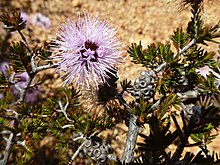
Beaufortia is a genus of woody shrubs and small trees in the family Myrtaceae and is endemic to Southwest Australia. The genus Beaufortia is closely related to Melaleuca, Calothamnus, Regelia and several others, differing mainly in the way the anthers are attached to the stalks of the stamens, and in the way they open to release their pollen. Beaufortia anthers are attached at one end and open by splitting at the other.

Beaufortia sparsa, commonly known as swamp bottlebrush, is a plant in the myrtle family Myrtaceae, and is endemic to the southwest of Western Australia. It is an erect or spreading shrub with round, dished leaves crowded on the younger stems, and bright red flower spikes in the warmer months.

Calothamnus villosus, commonly known as woolly net-bush or silky net-bush, is a plant in the myrtle family, Myrtaceae and is endemic to the south-west of Western Australia. It is a tall shrub, often forming thickets. It has thin, cylindrical leaves and blood red flowers for many months of the year. It is superficially similar to Calothamnus quadrifidus but can be distinguished from that species by its flowers which have five stamen claws compared to the four of C. quadrifidus.

Regelia velutina, the Barrens regelia, is a species of flowering plant in the myrtle family Myrtaceae. It is endemic to the south-west of Western Australia. It is a large shrub with greyish green, velvety leaves and large clusters of brilliant red to orange flowers on the ends of its branches in spring and summer.

Melaleuca scabra, commonly known as rough honey-myrtle, is a species of shrub that is endemic to a small area on the south coast of Western Australia. It has warty leaves and profuse, pink to purple heads of flowers between July and November.

Beaufortia anisandra, commonly known as dark beaufortia, is a plant in the myrtle family Myrtaceae, and is endemic to the southwest of Western Australia. It is a densely branched shrub with egg-shaped, upward pointing leaves and which bears heads of dark bluish-purple to red flowers with stamen bundles of different lengths. It is reported to have an unpleasant odour.

Beaufortia bracteosa is a plant in the myrtle family, Myrtaceae and is endemic to the southwest of Western Australia. It is a shrub growing to a height of about 1 m (3 ft) with red to maroon flowers and woody fruit.
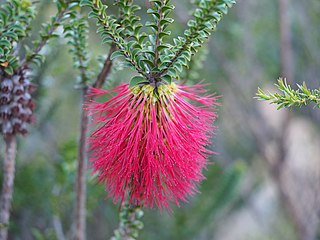
Beaufortia decussata, commonly known as gravel bottlebrush, is a species of flowering plant in the myrtle family, Myrtaceae and is endemic to the southwest of Western Australia. It has long stems branching only near the upper ends, and scarlet to orange-red flowers in a bottlebrush shape beneath the branches.

Beaufortia cyrtodonta, commonly known as Stirling Range bottlebrush, is a plant in the myrtle family, Myrtaceae and is endemic to the southwest of Western Australia. It is a compact shrub with crowded leaves which appear greyish due to their covering of fine, soft hairs. It has heads of red flowers in spring and occurs in the Stirling Range district.

Beaufortia empetrifolia, commonly known as south coast beaufortia, is a plant in the myrtle family, Myrtaceae and is endemic to the southwest of Western Australia. It is a highly branched shrub with small, crowded leaves and pinkish to purple flowers in small, bottlebrush-like spikes in the warmer months. It is similar to Beaufortia micrantha except that its leaves are slightly larger.
Beaufortia eriocephala, commonly known as woolly bottlebrush or woolly beaufortia, is a species of flowering plant in the myrtle family, Myrtaceae and is endemic to the southwest of Western Australia. It differs from other beaufortias in having woolly red flowers and hairy younger leaves, with mature leaves that are less than 1 mm (0.04 in) wide.

Beaufortia incana, commonly known as grey-leaved beaufortia, is a plant in the myrtle family Myrtaceae, and is endemic to southwest of Western Australia. It is a shrub with crowded leaves that appear whitish due to their covering of fine, soft hairs on both surfaces. It has almost spherical heads of red flowers in spring.

Beaufortia macrostemon, commonly known as Darling Range beaufortia, is a plant in the myrtle family, Myrtaceae and is endemic to the southwest of Western Australia. It is a low shrub with multiple stems, hairy young leaves and three stamens in each stamen bundle.

Beaufortia micrantha, commonly known as small-leaved beaufortia or little bottlebrush, is a species of flowering plant in the myrtle family, Myrtaceae and is endemic to the southwest of Western Australia. It is a compact shrub with tiny leaves pressed against the stems and profuse heads of purple or pinkish-coloured flowers.

Beaufortia orbifolia, commonly known as Ravensthorpe bottlebrush, is a species of flowering plant in the myrtle family, Myrtaceae and is endemic to the southwest of Western Australia. It is an erect or spreading shrub with round, dished leaves crowded on the younger stems, and bright red flower spikes. It is found in laterite hills near Ravensthorpe. It is distinguished from other beaufortias by having green stamen bundles with the free ends red.

Beaufortia purpurea, commonly known as purple beaufortia, is a species of flowering plant in the myrtle family, Myrtaceae and is endemic to the southwest of Western Australia. It is an erect or spreading shrub with linear to egg-shaped leaves and purplish-red flowers in dense heads on the ends of branches which continue to grow after flowering.
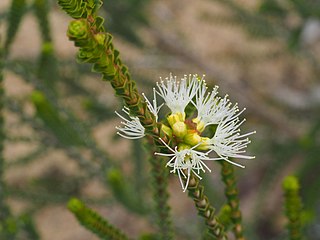
Beaufortia sprengelioides is a species of flowering plant in the myrtle family, Myrtaceae and is endemic to the southwest of Western Australia. It is a rigid, spreading shrub with crowded, round leaves and small, roughly spherical heads of pale pink flowers on the ends of its branches. It was one of the first Australian plant species collected by Europeans and has had several name changes since then.

Beaufortia squarrosa, commonly known as sand bottlebrush, is a species of flowering plant in the myrtle family, Myrtaceae and is endemic to the southwest of Western Australia. The Noongar peoples know the plant as buno. It is sometimes a dense shrub, others straggling with 4 neat rows of small, oval leaves along the stems, and heads of red, orange or yellow flowers in the warmer months.
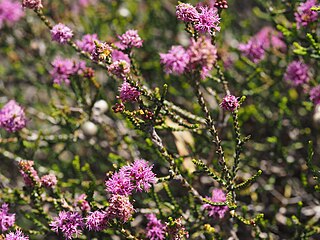
Regelia cymbifolia is a plant in the myrtle family, Myrtaceae and is endemic to the south-west of Western Australia. It is a much branched shrub bearing tiny, wedge shaped leaves and clusters of deep pink to purple flowers on the ends of its branches in spring.
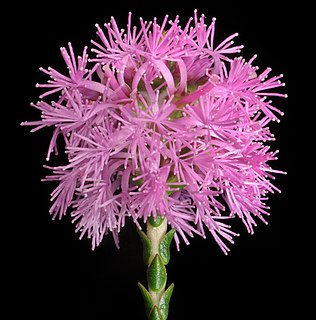
Regelia inops is a plant in the myrtle family, Myrtaceae and is endemic to the south-west of Western Australia. It is an upright but often spreading shrub with tiny wedge shaped leaves and small heads of pink flowers on the ends of its branches in the warmer months.
